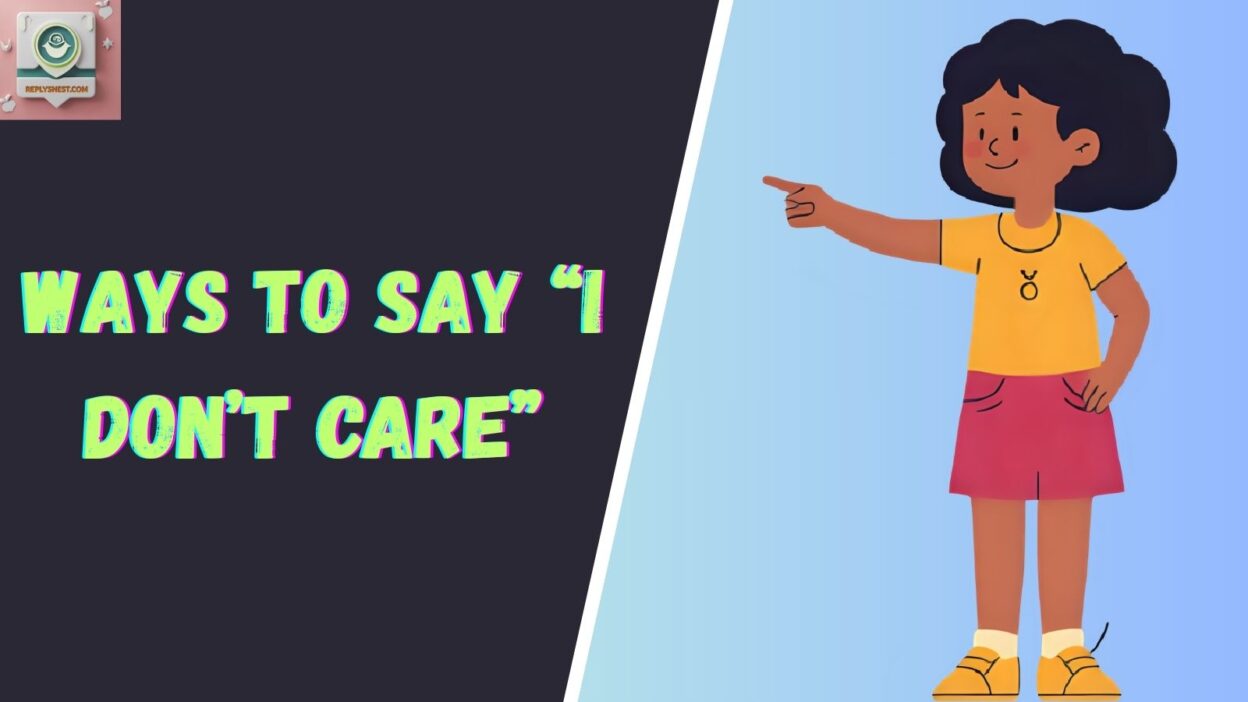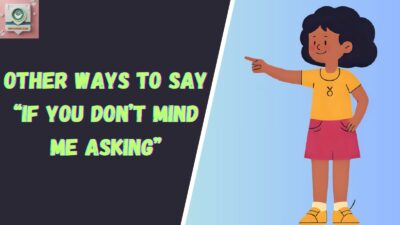When someone says “I don’t care”, it can sometimes come across as cold or dismissive—even if that’s not the intention. Often, we don’t mean to sound rude; we simply want to express neutrality, indifference, or that a matter doesn’t strongly affect us. But language is powerful, and the words we choose can soften or sharpen how we come across. Ways to Say “I Don’t Care”.
When I’m in a professional setting, I try to be polite and use a softer phrase instead of blunt expressions. For example, saying something like “that’s not really my cup of tea” makes the conversation easier while still showing my preferences. It signals that the matter is not my priority without sounding dismissive or rude.
In a relationship with a colleague or friend, choosing words carefully can avoid bother and prevent sounding disrespectful. I’ve learned that a small shift in tone can make a big difference in how others perceive what I have to say, especially when the context requires a more professional response.
On the other hand, there are moments where casual or blunt choices feel right. Around close friends, I might laugh and say “whatever floats your boat” or “not my circus, not my monkeys.” At times, I’ve even thrown in a playful “darn,” “crap,” or “damn” when I just don’t care about a problem.
These little phrases give me a way to express that something means nothing to me, but still fit the conversation naturally. Whether I say “I’m not a fan” or simply “don’t give a sh*t,” the choice depends on who I’m talking to, the audience, and whether I want to keep things lighthearted or seriously detached.
1. “I’m okay with whatever works best for you”
Best use: When you want to show flexibility and kindness in a decision.
Not to use: If you actually do have a preference (it may backfire).
Other ways to say: “I’m flexible,” “I’m good either way.”
Example: “Where should we eat tonight?” → “I’m okay with whatever works best for you.”
Read More: Funny Ways to Say “You Have to Pee”
2. “I’m easygoing about it”
Best use: Casual conversations where you want to show you’re laid-back.
Not to use: Formal business settings—it may sound unprofessional.
Other ways to say: “I’m relaxed about it,” “No strong opinion here.”
Example: “Do you want to watch a movie or play cards?” → “I’m easygoing about it.”
3. “I don’t mind either way”
Best use: Neutral situations where both options are fine with you.
Not to use: If you need to make a definite choice.
Other ways to say: “Either works,” “No preference.”
Example: “Should we start at 3 or 4?” → “I don’t mind either way.”
4. “I’m open to whatever you decide”
Best use: When letting someone else take the lead.
Not to use: If the decision really requires your input.
Other ways to say: “Your call,” “I trust your judgment.”
Example: “Should we pick this design or that one?” → “I’m open to whatever you decide.”
5. “I’m fine with both options”
Best use: Group settings where you don’t want to complicate things.
Not to use: When one option truly doesn’t work for you.
Other ways to say: “I’m okay either way,” “Both are fine.”
Example: “Would you rather sit inside or outside?” → “I’m fine with both options.”
6. “I’m cool with that”
Best use: Informal, friendly exchanges.
Not to use: In professional contexts—it can sound too casual.
Other ways to say: “That works for me,” “Sounds good.”
Example: “Let’s grab coffee at 10.” → “I’m cool with that.”
7. “It doesn’t matter much to me”
Best use: When you genuinely have no preference.
Not to use: If it might sound dismissive in a sensitive discussion.
Other ways to say: “No big difference to me,” “I’m fine either way.”
Example: “Do you want the blue or green notebook?” → “It doesn’t matter much to me.”
8. “I don’t have a strong opinion on this”
Best use: Professional discussions where you want to remain neutral.
Not to use: When your input is expected for decision-making.
Other ways to say: “I’m neutral on this,” “I don’t lean strongly either way.”
Example: “Should we use A or B in the presentation?” → “I don’t have a strong opinion on this.”
9. “I’m happy to go along with what works best”
Best use: Group planning or teamwork.
Not to use: If you’re not actually comfortable with all options.
Other ways to say: “I’ll follow your lead,” “I’m fine with the group’s choice.”
Example: “Should we start with introductions or jump into the main agenda?” → “I’m happy to go along with what works best.”
10. “I’ll go with the flow”
Best use: Informal, social gatherings where flexibility is valued.
Not to use: In professional or serious discussions.
Other ways to say: “I’ll adapt,” “I’m flexible.”
Example: “Plans might change later.” → “That’s fine, I’ll go with the flow.”
11. “I don’t feel strongly either way”
Best use: Sensitive discussions where you want to be honest but gentle.
Not to use: When the outcome does matter to you deep down.
Other ways to say: “I’m neutral,” “I’m fine with both sides.”
Example: “Do you think we should paint the room white or cream?” → “I don’t feel strongly either way.”
12. “Whatever you think is best”
Best use: Respectful deference to someone’s expertise or choice.
Not to use: If you’re avoiding responsibility in an important matter.
Other ways to say: “I trust your judgment,” “I’ll leave it to you.”
Example: “Should we go with strategy A or B?” → “Whatever you think is best.”
13. “That works for me”
Best use: Simple, agreeable response to a plan.
Not to use: When you actually have a concern.
Other ways to say: “Sounds good,” “That’s fine by me.”
Example: “Lunch at 1?” → “That works for me.”
14. “I’m flexible on this”
Best use: Workplace or planning conversations.
Not to use: If you secretly hope for a specific outcome.
Other ways to say: “I can adjust,” “I don’t have a fixed view.”
Example: “Do you prefer meeting in person or online?” → “I’m flexible on this.”
15. “I’ll let you decide”
Best use: When you trust the other person’s judgment.
Not to use: If they really want your input.
Other ways to say: “Your choice,” “I leave it to you.”
Example: “What topping should we get on the pizza?” → “I’ll let you decide.”
16. “I don’t mind”
Best use: Quick, simple response in casual chats.
Not to use: In delicate situations where it might sound dismissive.
Other ways to say: “Either is fine,” “I’m good with whatever.”
Example: “Tea or coffee?” → “I don’t mind.”
17. “I’m okay either way”
Best use: Everyday choices where you’re fine with both.
Not to use: If one option really doesn’t suit you.
Other ways to say: “No preference,” “Both are fine.”
Example: “Want to walk or drive?” → “I’m okay either way.”
18. “No preference on my end”
Best use: Professional or team settings where clarity matters.
Not to use: Informal chats—it may sound stiff.
Other ways to say: “I’m good with both,” “Either works for me.”
Example: “Do you want me to send it as a PDF or Word doc?” → “No preference on my end.”
19. “I’ll adapt to whatever’s decided”
Best use: Workplace or group projects.
Not to use: If adapting will be difficult for you.
Other ways to say: “I’ll adjust,” “I’ll work with what’s chosen.”
Example: “We might shift the deadline earlier.” → “I’ll adapt to whatever’s decided.”
20. “I’m fine with the group’s decision”
Best use: Group meetings where consensus matters.
Not to use: If you’re actually uncomfortable with the choice.
Other ways to say: “I’m good with what’s agreed,” “I support the decision.”
Example: “Should we go with the first draft or second?” → “I’m fine with the group’s decision.”
21. “I’ll follow your lead”
Best use: Respectful acknowledgment of another’s authority or expertise.
Not to use: When you’re expected to take initiative.
Other ways to say: “I trust you,” “I’ll go along.”
Example: “Should we prioritize marketing or operations first?” → “I’ll follow your lead.”
22. “I’m comfortable with either”
Best use: Calm, neutral situations.
Not to use: When one choice actually makes you uneasy.
Other ways to say: “Both work for me,” “I’m okay either way.”
Example: “Would you rather start early or later?” → “I’m comfortable with either.”
23. “It’s all the same to me”
Best use: Casual conversations about unimportant details.
Not to use: If tone could come across as dismissive.
Other ways to say: “Doesn’t make a difference to me,” “Either is fine.”
Example: “Do you want the pen in red or black?” → “It’s all the same to me.”
24. “I’m fine whichever way”
Best use: Everyday casual chats.
Not to use: In formal discussions.
Other ways to say: “Either works,” “Both are okay.”
Example: “Should we walk through the park or along the street?” → “I’m fine whichever way.”
25. “I’ll go along with your choice”
Best use: Showing support while letting others decide.
Not to use: If you’re quietly unhappy with the choice.
Other ways to say: “I’ll back your decision,” “I’ll go with what you choose.”
Example: “Do you want pizza or pasta?” → “I’ll go along with your choice.”
Conclusion
Saying “I don’t care” can sometimes sound dismissive even if you don’t mean it that way. By using alternatives like “I don’t mind either way,” “I’ll let you decide,” or “I’m fine with both options,” you not only soften your tone but also show respect, flexibility, and care for the other person’s input. Personally, I’ve found that choosing warmer alternatives helps keep conversations smoother, especially in group or work settings where tone matters as much as words.
Remember, communication isn’t just about what you say—it’s also about how you make others feel.
Editor’s Picks (and Why People Choose Them)
- “I don’t mind either way” – Simple and polite; works in most situations.
- “I’ll let you decide” – Shows trust and respect for the other person.
- “That works for me” – Short and agreeable; easy to use.
- “I’m flexible on this” – Perfect for workplace collaboration.
- “Whatever you think is best” – Empathetic and deferential.
- “I’m okay with whatever works best for you” – Shows care and consideration.
- “I’ll go with the flow” – Friendly and casual; great for social plans.
- “I’m open to whatever you decide” – Soft and respectful, avoids friction.
- “No preference on my end” – Professional and clear in work settings.



